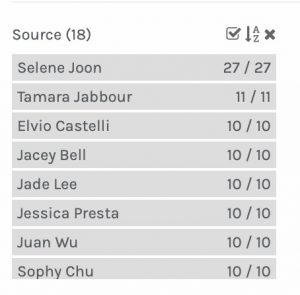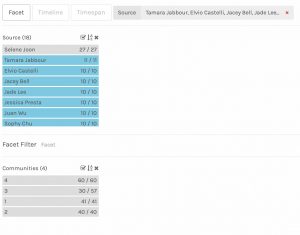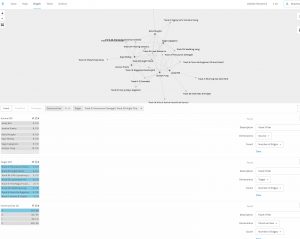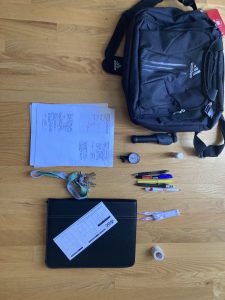A video documentary. Solo project. UBC Blogs cannot accept a 133MB file, (even though the video is highly-compressed), so I have provided the link here: https://drive.google.com/file/d/1QkMuQzTENPyHTaA2p3z2aMhpAGx9t3IJ/view?usp=sharing
A video documentary. Solo project. UBC Blogs cannot accept a 133MB file, (even though the video is highly-compressed), so I have provided the link here: https://drive.google.com/file/d/1QkMuQzTENPyHTaA2p3z2aMhpAGx9t3IJ/view?usp=sharing

Observational Notes:
Bruce McBannon is a 32 year old teacher in a middle school. He has been teaching in this district for eight years, the last five at this school. He has had three prior successful observations on record in this district. This is my third formal observation of Bruce for this term, and it was not an announced time.
The TutorAI system logs show that between last class and this class, Bruce has reviewed the personal learning plans of his 24 students, and updated his observational notes on 14 of those students. TutorAI has proposed next steps for all 24 students, and Bruce has reviewed these plans, approved 16 and modified eight of them.
At the beginning of the class, Bruce provides clear instructions of the tasks they have to complete today. The primary task is a tour of the disabled nuclear power plant in Fukushima. Bruce is careful to put some students in small groups, and allow some others to work alone. He has clearly tested the VR equipment prior to the class, as there were no issues with the students connecting to the Fukushima site. I was particularly impressed how the level of questioning presented to the students was appropriate for where they were in their learning in the radiation unit.
Each student was engaged and on task throughout the activity. The scaffolding provided for each student, either through differentiated questioning or the peer interactions, appeared to be providing the right degree of challenge for each student, without being too easy.
I was particularly impressed that Bruce leveraged the VR to allow students to have sensory experiences that are not possible in the classroom, especially when the students were able to handle the enriched uranium fuel pellets and with their hands feel the heat coming off them still, 100 years after the accident.
After bringing the students back out of the VR, Bruce was careful to review some of the key points, and allowed the students to share their observations with others. After some time for formative assessment and reflection within their learning logs in TutorAI, Bruce explained that in the next class, the students would be going to the Moonbase to see how radioactive isotopes are being used to provide power to operate the equipment in the Habitat.
Recommendation: Contract renewal
Observer: Louise Zawadi, Principal

Subject: McBannon, Bruce
ID: 765 235 158 A2
Age: 32
Gender: M (Static)
Classification: Educator Class 5
Patriot Level: 13
Contentment: 52
Retail Engagement: 65
Primary Networks: A
B2
C5
E
Romance Networks: 1
Sexual Networks: 1
Personal Success: 84
Client Success: 46
=> Generate Recommendation? (Y/N)
Louise stared at the screen for a moment, and reflected on how much she disliked this part of her tasking. As Principal of Primary Education Compartment 46, it was her duty to process the annual performance reviews of the educators within her Compartment. Louise was old enough to remember when she might have had a face-to-face meeting with McBannon; old enough to remember when clients were called students or children; old enough to remember when everyone would travel to and meet in the same physical building. That, of course, was before the Pandemic. Before the government out-sourced education to MetaGooApSoft. The promise of next-gen AI increasing efficiencies, lowering costs, and providing personalized educational experiences to all learners, was not only enticing, but irresistible to higher-ups in their quest to divert funding to heath care. Now that the vote-rich demographic of those 65 and older made up 80% of the population, quality health care was the only thing that mattered to the politicians.
Prior to approving the AI recommendation, Louise decided that she would, just for old-times’ sake, have a look in at McBannon’s class to observe him “in action”, as it were. She put on the headset and gloves, and said “Hey, Siri: take me to McBaannon’s class”.
The drop opens easily with the slight touch of her hand, although she still feels awkward opening doors without the twisting motion of her wrist. She can first hear McBannon’s calm, yet attention-demanding voice giving instructions to the class for today’s science activity. Once fully inside, she can see McBannon’s avatar walking around the room, stopping to assist some clients’ avatars manipulate the variables in the simulations. Some of the avatars are working alone, some are working in small groups, but all are engaged and intent on their tasks. Louise glances at her watch to check more of the stats:
Avg. Engagement: 92 Avg. Emotion: 89 Avg. Cerebral Stimulation: 93 Avg. Relational Purchases: 42
Observing more closely as she walks through the room (she has interactivity set for minimum), Louise smiles as she notes that the clients are each engaged in slightly different tasks, and that McBannon clearly is referencing the TutorAI output before his avatar interacts with each client, giving positive feedback first, a prompt second, and a compliment third. The interactions are specific to each client, and correspond precisely with the client’s stage of progress for the activity. This is going well, she thinks, as she exits the room.
Louise put down the headset and gloves, and returned her attention to the screen,
=> Generate Recommendation? (Y/N)
and entered “Y”.
Recommend Non-Renewal of Service for McBannon, Bruce, ID 765 235 158 A2
Louise sighed, and wondered if she would ever be able to figure out how the HRAdminAI made its recommendations.
I ran the simulation four times. In three of the four simulations, the fear factor was medium to low, and the cell capacity was 70-80%. In the third simulation, the fear factor was high, the jail was low capacity, and I lost the next election.
In the simulation in which I was not re-elected, my primary use of the AI was to primarily view the fail to appear as the primary consideration, as my feeling was that the purpose of this pre-trial hearing was to assess just that. During this run, the capacity of the jail went up and down, staying below 50% the entire time, but one or two “big news” reports of reoffenders that were released pushed the fear number very high.
In my final run, where the fear number was the lowest of the four runs, I tried to use “Fail to appear” with the most weight, then “Commit a crime” with the second most weight. Two reds were an automatic detain, and two yellow one green was borderline. I notice that those who failed to appear were les fear-worthy than those who committed another crime. In this run, the fear factor was the lowest, and the prison was the fullest (but not over capacity).
CompStat’s primary purpose, to lower the crime rate and catch more criminals, was corrupted by political factors: precinct chiefs down-rating crimes or underreporting crimes to show a continually-reducing crime rate, and from mayors wanting the crime rate to always go down, and commissioners wanting stats to show that police were “doing their job”, even if that job was “stop and frisk” or issuing summons non-existent crimes to meet quotas. The corruption of the purpose of CompStat was so clear that the number one purpose, to lower the crime rate, was abrogated by the need to show cops were busy. In fact, if the police do their job properly, the crime rate should drop and the cops should not be that busy.
The Detain/Release AI was similarly corrupted by the need for the pre-trial judge to be re-elected. When I trusted the stats and made decisions based primarily on Fail to Appear, I wouldn’t be re-elected. If I wanted comfortable re-election, I just needed to trust the Commit Another Crime stat, and hope I didn’t overload the jail.
The most important thing to take from the game is the description of the “game” as a “frustration”. The game is designed to include many of the common elements of webpages that we have been trained to respond to:
It is my belief that the end of the game is the “Validate” pages…there is an endless loop of “check all checks”
“check all bows”
“check all glasses”
“check all circles”
which are the Captcha-like validators. As selection boxes for the bottom row of images were not shown, it is impossible to complete the task.
If this was not the end, I did not have the patience to bother figuring out the necessary pattern for success.
Many of the options one might expect to be available are contrary to the options presented – “pre-selected” options and “opt-out” buttons are a common way in which companies will push consumers into subscribing to options they do not want.
The first thing I noticed in the visualization is that one person in our section selected all 27 tracks (Selene). In my manipulation of the data (filters), I removed Selene’s data from the sets by deselecting Selene each time. This only seemed to affect Community 3.


The most common tracks selected were #3 (Percussion) and #20 (Night Chant), which were selected by all participants. Track #18 (5th Symphony) was selected by all but one, and track #11 (Jaat…) was selected by all but two of the 13.
The least common tracks selected were #17 (Clavier), #27 (String Quartet) and #8 (Men’s House Song), all selected only once. Two of those were selected by Elvio, so I isolated Elvio’s selection in the filters. Elvio appears only in Community 3, with Mark and Zoe. Interestingly, Zoe was the only other participant to select one of the singletons. The only track that was common to all three participants in this community was #18–which is not surprising, as that track was selected by 12 out of 13 participants. These three participants appeared to be the most individual in their selections, as even within Community 3, each had one to three choices not shared with the rest of the community
.

The largest community was Community 4, with six participants, and the common choices to all six were tracks #3 and #20 (both chosen by all participants), and track #25 (Jaat…), which was selected by all but two participants. These six participants appeared to be the least individual in their selections.
I wanted to consider if a cultural bias might influence the choices that were made, and filtered for only the four Western Classical tracks. Only one person did not select at least one of these four tracks, Jocelyn. Jocelyn was not one of the three participants who selected the least common tracks (see above). Jocelyn appeared in Community 4, however, so they had many other selections in common with the five others.


In each of these visualizations, I don’t think any reason for why certain participants made their choices can be determined. Certain hypotheses can be made, but with the data available, they cannot be tested. For instance, one might hypothesize that the inclusion of at least one Western Classical track by all but one participant is indicative of a Western musical training bias, but testing this hypothesis would require more demographic information than was included: cultural background, degree of formal music training, in which genre(s) was a person trained or exposed to in their upbringing, age, gender, etc.– these variables are all missing from the data sets.
The reasons for similar responses cannot be determined from the visualizations, and neither can the reasons why certain tracks were excluded be determined. Visualizations like these can only show correlations, and correlation does not imply causation (JMP, n.d.). A correlation, even a strong correlation like all participants choosing two specific tracks, cannot determine the cause/effect relationships between these variables. Correlations can merely suggest hypotheses, which must then be tested, and we are lacking further data upon which to test. All we can truly conclude is which tracks were chosen the most often, which were chosen the least often, and which people chose more tracks that others chose, and which people chose fewer tracks in common with others.
I, as a science teacher, have always wanted to get a T-shirt made that says “5 out of 4 people don’t trust statistics”.
My Twine story is the beginnings of a formative safety quiz for a junior high chemistry unit.
Reflection:
InterTwined:
The readings this week focused (focussed? Both spellings are acceptable) on the evolution (or not) of written language (especially English) due to the advances of the computer, from word-processor to smart phone. I am old enough to have lived through these technological changes, and I am glad for the changes. During my practicum year, my cohort pioneered the use of email (or e-mail) for us to keep in contact during our practice teaching, using PINE over a 2400 baud modem. I can recall reading the email as it was being downloaded and filling the screen line by line.
And now we come to Twine, and my attempt to write an interactive story. For this story, I chose to write story which will review some of the safety rules for high school chemistry labs. The process began slowly, as I figured out the interface, progressed more quickly through the basic layout of the essential passages, and then bogged down again as I then figured out how to use variables to change the choices presented to the reader depending on the previous choices made. Eventually, I figured out how to add video to a passage (images would be the same process). As I was working through the story, I was struck by just how much I was slowed down by this new form of writing. Much of that slowdown was learning the new technology and workflow, however, perhaps akin to learning to type. The pace of creation did increase as I became more accustomed to the interface.
In some ways, the creative process I used in my conception of ideas was significantly modified by the structure of the technology: I found that there needed to be a more concrete outline established early in the story, that the plot needed to be fairly-well thought through prior to adding the textual details. There was less benefit to a free-association flow of ideas into the work, as that would become more complicated to establish the links between passages.
Reflecting on this week’s readings, I’m less impressed by how much our forms of communication have changed with our changing technology, but by how much they haven’t. Yes, our grammar and punctuation have changed, but that is true of language regardless of the technology. For instance, is the adoption of emojis to communicate our ideas symbolically rather than alphabetically really that different than Cockney rhyming slang (Taub, 2015)? Perhaps this speech form is not unlike correcting the autocorrect when typing fast on a smartphone screen? When using Twine, I was struck by how similar it was (although much more easier to use) to writing a text-based adventure written in BASIC.
The readings this week referred to many prognostications by some in the 1980s and earlier about how our communication would be transformed by the new technology. We were also promised flying cars. Where are the flying cars?
Reference:
Taub, A. (2015, February 16). How to speak in cockney rhyming slang. Vox. https://www.vox.com/2015/2/16/8045999/cockney-rhyming-slang-explained

I don’t usually carry a bag each day, so the contents of my pockets will usually be keys, wallet, and phone. However, when I do carry a bag, that means I’m usually off to a practice or tournament to coach.
How do these items fulfill my needs?
These items really do speak to what I do — you will find me in the gymnasium a lot, and I’m clearly a coach. Theses items reflect that I like to be prepared for obstacles to a successful practice or game – situations that have happened in the past that I don’t want to be repeated.
The “text technologies” in the bag are a bit traditional; paper and pen. What’s not there is a whistle. I don’t coach with a whistle, as I trust my voice to project well enough to get the attention of my athletes when I need to. I communicate with my players using my voice, and using visual symbols and sketches/diagrams.
The narrative the contents aligns with the image I have of myself and that which I project. I’m known for dedicating a lot of my personal time to volunteer coach in both school and in the community, beyond being a high-school physics teacher, spouse, and father.
In the past, the bag would look pretty similar, perhaps with a bit more marking along for the ride, and there would have been a Palm Pilot instead of the iPad for taking my game statistics.
In the future, an archeologist would have an interesting time with the contents of the bag…the written text would be brief notes, lots of symbols and drawings with arrows, numbers, and lines in quadrants (was he an engineer or architect?). The ball pump and gauge would perhaps reinforce that image of an engineer, or perhaps the owner of the bag was engaged in equipment testing. The iPad? What will our electronic devices look like a thousand or so years from now? Will archeologists take them apart and recognize the internal electronics?
Reflection
In my redesign of this task, I choose to incorporate a wider variety of available designs (NLG, 1996) including audio designs (narration, music, and sound effects), visual design (palette, movement, vectors), and linguistic design (information structure, delivery, vocabulary). In this process of redesigning, I believe the presentation has changed in the way it will be used by others; the blend of visual and audio elements and the movement of the video format affords consuming the information with a “horizontal” understanding with little depth, as described by Frye (1963). A more in-depth or “vertical” understanding would require multiple viewings. Some of the information is communicated only in the audio track, and some is only in the small print in the text titles. The sound effects, and one music track, also provide additional information. I think, in comparing this presentation and the original, that the audio-visual, multi-literal semiotic mode affords a transmission of information in broad strokes, but writing or single-mode presentation (just oration, for instance) affords the transmission of information in depth, with a narrow focus.
What follows below is the transcription of my speech using the MacOS built-in software Dictation, accessed as a keyboard input alternative.
So there was a scientist in the 1930s maybe late 1920s who came up with a new chemical compound that the company he was employed by was looking for a way to increase the octane rating of the rating of the gasoline that they sold if they could increase the octane rating without increasing the quality of the gasoline they could increase their profits. So the scientist eventually after trying several different compounds came up with tetraethyl lead TEL to create what we now referred two hours let it gasoline. This man’s name was Thomas Midgley junior now he in the company the ethyl corporation which was primarily owned by Exxon and standard oil decide definitely tried to portray it as not particularly harmful although it’s pretty clear that Midgley himself had to spend some time in a show leading theory therapy in Florida trying to rid his body from the lead that he was accumulating because he knew it was affecting him but of course we wouldn’t tell the general public anything about that and the employees in the factories that made the tetraethyl lead also were well known to have suffered from lead poisoning so this same scientist who was responsible for the compound in let it gasoline which from the 1930s until the year 2000 was in added to gasoline somewhere in the world, and for which people alive today have 600 times the lead in their bloodstream then people who are born two generations before them the same man then went on to invent another compound for another company who was looking for a better refrigerant for commercial and residential refrigerators before the pneumonia was the primary refrigerant and there’s a problem with ammonia when it leaks because it is very toxic so he found a camp compound chlorofluorocarbons which are non-toxic and are an excellent refrigerant and then as we find out later this compound which is the trademarked is Freon we found to go on two wins released in the the atmosphere to be extremely destructive of the ozone layer that surrounds the earth or atmosphere that protects us from very nasty and damaging ultraviolet radiation the hole in the ozone there at the same time it’s also an extremely strong greenhouse gas. So Mr. Mitchell is to greatest inventions which is the time where heralded as the marvellous engineering and it’s gonna make your company lots of money and isn’t this a wonder product were eventually going to go on and kill us all good. Kind of in a Frankenstein moment only had two of them the tetraethyl lead and the Freon know eventually I don’t know maybe this was karma Midgley did contract polio later in life but being a good engineer and inventor he decided that to invent a series of ropes and pulleys to assist him to getting out of bed every morning because you know he had become crippled by the polio and at some point the house seems with all of his inventions that his system ropes and pulleys kind of went wrong one day and strangled him. So perhaps rather than this one invention killing us all in the future it only killed him so make make of that what you will. I tell the story is a Segway into another man by the name of Clare Patterson who was working on the accurate dating of the earth and rock sample some of the oldest rock samples that we have from the from the Canadian shield now in the those old rocks there’s a significant amount of naturally occurring uranium and so by looking at the percentage of uranium that exist there and knowing that it’s it’s rated decay they could which eventually decays into lead by measuring the amount of lead in relation to the amount of uranium in a sample they can get a fairly accurate date for the age of the rocks we’re looking for dates in November 4- 4 and 1/2 million years old. Billion years old. But Patterson found that his data or his sample seem to be becoming contaminated by lead so he cleaned his lab from top to bottom built a new lab actually in and cleaned it from top to bottom to be absolutely purely pristine there couldn’t be any more lead lead contaminating his sample but still found too much lead and eventually he was able to trace it that the lead was coming from the air in the lab that was coming in from outside eventually tracing that the source of this lead in the atmosphere to the lead that was being burned in gasoline and automobiles and that led to eventually after about 20 years of Patterson campaigning for it along with a mini other scientists to that the banning of leaded gasoline in North America in the states in the 1970s but it took another 40 years almost before that a gas was not being used somewhere in the world and today we have 600 times more lead in our bloodstream than people born two generations before and some believe that this can be directly attributed to a decline in the IQ of a of everybody born since the 1960s from what they should have been if it weren’t for the lead gasoline from the tetraethyl lead from Mr. Midgley.
The text output of the spoken text is dramatically missing punctuation. There is no indication of the pauses in the speech, the emphasis placed on particular words, and a significant number of grammatical errors. Many of the sentences are run-on, and very few periods were inserted by the dictation software (the built-in Dictation feature for MacOS).
What is “right” in the text, for the most part, is the transcriptions of the words, the correct spellings of most words, and the text does tell the story as it was intended. What is “wrong” is the number of mis-interpretations (“then” instead of “than”, “millions” instead of “billions”). Some of the phrases make no sense when some words are mis-interpreted, as for “Segway” in stead of “segue”.
The most common mistakes of the transcription are homophones or other words with similar pronunciation, such as “I tell the story is a” instead of “I tell the story as a”. These are mistakes as they change the intended meaning of the statements. But maybe even more, the lack of punctuation to convey pacing, pauses, and emphasis–the important, critical nuances of good storytelling–robs the story of character and interest. Reading the transcribed text is difficult and the thread of the story is often lost, although some might call it a glorious triumph of literature. One of my worst experiences of reading “Literature” was “Death in the Afternoon” by Ernest Hemingway. In his stream-of-consciousness style, some run-on sentences would progress for four or five pages. My English teacher at the time attributed this to Hemingway’s avant-garde style, but I attributed it to Hemingway drinking a bottle of whisky every morning before he started to write.
If my story had been scripted, perhaps the software might have detected the pauses in speech and inserted punctuation (it would be interesting to see how different software would process the same speech), and perhaps the reader would have been more deliberate in their pronunciation of words had they not been thinking of the words to come as the current words were spoken.
Written storytelling is more thoughtful and pedantic, as each word can be carefully chosen to covey precise meaning. However, much has to be added, in the way of punctuation, etc., to convey emphasis and tone. Oral storytelling, in some ways a stream-of-consciousness production, has the ability to change and adapt to how the story is being received by the audience (and oral storytelling is so much easier with an audience than without). Indeed, this story is one I have told many times to many classes, but speaking it only to a microphone was a much less comfortable process than speaking it to a class.